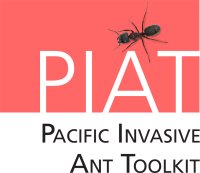Nest injection
It is very important to note that as this this method uses highly toxic chemicals, it should only be used by operators with the appropriate training and experience. An untrained operator may make the problem worse by causing the ant nest to fragment, and could unnecessarily contaminate the area. If an experienced nest injection operator is not available, it is safer and more effective to use a granular bait.
|
Nest injection (or precision drenching as it is also known) provides an effective means of treating individual red imported fire ant mounds. A toxicant concentrate is mixed with water and injected into the mound with a hollow metal wand connected to a pressurized backpack garden sprayer. Depending on the make of backpack sprayer/wand it may be necessary to extend the length of the wand to reduce the risk of ant stings during treatment. The toxicants used are typically either a synthetic pyrethroid such as bifenthrin (e.g. Talstar), cypermethrin (e.g. Amdro Quick Kill) or an alternative neurotoxin such as a fipronil based product. |

Red imported fire ant mounds like the one above are injected with pesticides to kill off the entire next (© Alex Wild alexanderwild.com) |
| As product toxicant concentrations vary, it is essential that the manufacturer's recommendations for safe handling, dilution and application rates are followed.
It is important that the mound is not disturbed before treatment, as this will result in workers moving the queen (or possibly the whole nest) to safety deeper underground or to an adjacent mound. The wand is inserted deep into the nest and toxicant is pumped in. The wand should be moved gently up and down in the nest as the toxicant is pumped to ensure all levels of the nest are drenched with insecticide. This procedure is repeated at a number of different points around the mound to make sure the entire nest has been treated. As the ants are likely to respond aggressively to this intrusion, appropriate protective clothing (gloves, boots, overalls etc.) must be worn to protect workers from both the insecticide and the ants! It is best to treat fire ant nests in the mid-morning when the sun has begun to warm the nest and the ants are becoming active. Red imported fire ant mounds should be treated in spring or autumn, or when temperatures range between 21° and 29° C. At more extreme temperatures queens and workers are likely to be sheltering deep below ground where the liquid toxicant cannot reach. |

Pesticides are injected directly into the nest (© The State of Queensland, Department of Agriculture and Fisheries, 2016) |
|
Many nest injection campaigns are supplemented by the use of granular baits broadcast in the surrounding area to ensure eradication of the nest. As an alternative to using pesticides, a new method is to use super-heated water injected into the nests. This method is not commercially available yet, so contact Joshua King of the University of Central Florida for more information. A description of how to use the hot water treatment without nest injection can be found in the Non-toxic options section. |
Dr Joshua King (UCF) and Dr Walter Tschinkel (FSU) demonstrate the use of their hot water injection system, YouTube video (© djd14d) |
Information Sources
Lach, Barker. 2013. Assessing the effectiveness of tramp ant projects to reduce impacts on biodiversity. A report prepared for the Australian Government Department of Sustainability, Environment, Water, Population, and Communities
NC University, Red imported fire ants in North Carolina
UGA Extension, Managing imported fire ants in urban areas
eXtension, Red imported fire ants
content reviewed by Viv van Dyk, FBA Consulting, July 2017
